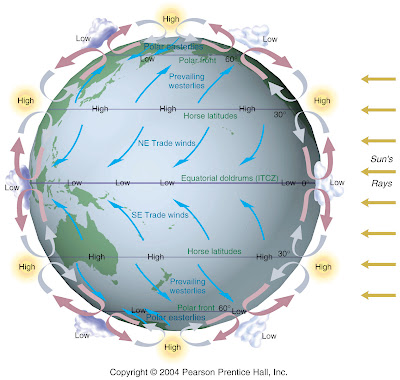
The prevailing wind systems of the earth blow from the several belts of high pressure toward adjacent low-pressure belts. Because of the earth's rotation (see Coriolis effect), the winds do not blow directly northward or southward to the area of lower pressure, but are deflected to the right in the Northern Hemisphere and to the left in the Southern Hemisphere. The wind systems comprise the trade winds; the prevailing westerlies, moving outward from the poleward sides of the horse-latitude belts toward the 60° latitude belts of low pressure (from the southwest in the Northern Hemisphere and from the northwest in the Southern Hemisphere); and the polar easterlies, blowing outward from the polar caps of high pressure and toward the 60° latitude belts of low pressure.
These are your Keywords:
Doldrums (5°N to 5°S)
Diurnal pressure variation is most noticeable. Low Pressure belt near the Equator.
Trade Winds (5° - 30° N/S)
Greatest Effect on set, drift, depth of equatorial currents. Fine clear Weather.
Horse Latitudes (30° - 35° N/S)
Diurnal pressure variation is commonly observe. Region of high pressure extending around earth 35°. Pole side of trade winds belt area of high pressure.
best review center
ReplyDeleteunlimited review
ReplyDelete